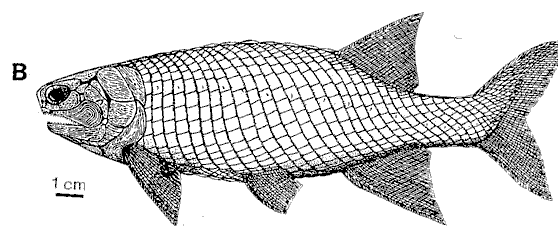
Novogonatodus kasantsevae
Early actinopterygian fish - family Gonatotidae
(fresh water)
Mansfield, Victoria, Australia
(south-east Gondwanaland)
| Mississippian Epoch | ||
| Paleozoic: Carboniferous Period |
Tournaisian Age |
| Famennian | Late Devonian | Mississippian | ||
| Viséan | Pennsylvanian | Timescale |
The Tournaisian is in the ICS geologic timescale the lowest stage or oldest age of the Mississippian, the oldest subsystem of the Carboniferous. The Tournaisian age lasted from 359.2 ± 2.5 Ma to 345.3 ± 2.1 Ma. It is preceded by the Famennian (the uppermost stage of the Devonian) and is followed by the Viséan.
The Tournaisian was named after the Belgian city of Tournai. It was introduced in scientific literature by Belgian geologist André Hubert Dumont in 1832. Like many Devonian and lower Carboniferous stages, the Tournaisian is a unit from West European regional stratigraphy that is now used in the official international time scale.
The Tournaisian coincides with Romer's gap, a period of remarkably little terrestrial fossils, thus constituting a discontinuity between the Devonian and the more modern terrestrial ecosystems of the Carboniferous.
In this age plants were generally small consisting mostly of Lycopods & ferns. The first terrestrial tetrapods appear. Sharks radiate due to the extinction of the Placoderms. Bony and lobed finned fishes also radiate, as well as Crinoids, Blastoids & Bryozoans.
The Climate was generally warm with high Sea levels. Minimal glaciatians occured at this time. The continents were arranged much the same as they were at the end of the Devonian. Gondwana straddled the southern hemisphere while Euramerica, located on the equator, continued to move towards Gondwana. Siberia occupied the nothern hemisphere. Yogi111207

Novogonatodus kasantsevae
Early actinopterygian fish - family Gonatotidae
(fresh water)
Mansfield, Victoria, Australia
(south-east Gondwanaland)
Location | Stage |
| Nova Scotia |
|---|---|---|---|
Tournaisian |
Ivorian |
350 |
Horton Bluff |
|
Hastarian |
356 |
![]() Horton Bluff - The Discovery- about a trackway made by a very large tetrapodomorph - each footprint was 30 cm long and they were spaced
30 cm apart. The tracks are deep with raised edges, suggesting that the animal was heavy and the mud very soft. The type of creature that made the trackway is not known.
Horton Bluff - The Discovery- about a trackway made by a very large tetrapodomorph - each footprint was 30 cm long and they were spaced
30 cm apart. The tracks are deep with raised edges, suggesting that the animal was heavy and the mud very soft. The type of creature that made the trackway is not known.
Blue Beach Fossils - a new privately run museum that just opened up featuring the flora and fauna of Horton Bluff, Nova Scotia, Tournasian fossils. It contains information about the site as well as some images of fossils that they have found and are currently working on.